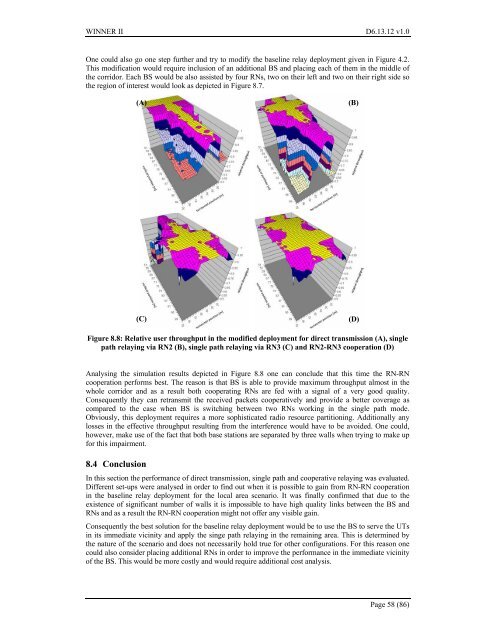IST-4-027756 WINNER II D6.13.12 v1.0 Final CG “local area ...
IST-4-027756 WINNER II D6.13.12 v1.0 Final CG “local area ...
IST-4-027756 WINNER II D6.13.12 v1.0 Final CG “local area ...
You also want an ePaper? Increase the reach of your titles
YUMPU automatically turns print PDFs into web optimized ePapers that Google loves.
<strong>WINNER</strong> <strong>II</strong> <strong>D6.13.12</strong> <strong>v1.0</strong>One could also go one step further and try to modify the baseline relay deployment given in Figure 4.2.This modification would require inclusion of an additional BS and placing each of them in the middle ofthe corridor. Each BS would be also assisted by four RNs, two on their left and two on their right side sothe region of interest would look as depicted in Figure 8.7.(A)(B)(C)(D)Figure 8.8: Relative user throughput in the modified deployment for direct transmission (A), singlepath relaying via RN2 (B), single path relaying via RN3 (C) and RN2-RN3 cooperation (D)Analysing the simulation results depicted in Figure 8.8 one can conclude that this time the RN-RNcooperation performs best. The reason is that BS is able to provide maximum throughput almost in thewhole corridor and as a result both cooperating RNs are fed with a signal of a very good quality.Consequently they can retransmit the received packets cooperatively and provide a better coverage ascompared to the case when BS is switching between two RNs working in the single path mode.Obviously, this deployment requires a more sophisticated radio resource partitioning. Additionally anylosses in the effective throughput resulting from the interference would have to be avoided. One could,however, make use of the fact that both base stations are separated by three walls when trying to make upfor this impairment.8.4 ConclusionIn this section the performance of direct transmission, single path and cooperative relaying was evaluated.Different set-ups were analysed in order to find out when it is possible to gain from RN-RN cooperationin the baseline relay deployment for the local <strong>area</strong> scenario. It was finally confirmed that due to theexistence of significant number of walls it is impossible to have high quality links between the BS andRNs and as a result the RN-RN cooperation might not offer any visible gain.Consequently the best solution for the baseline relay deployment would be to use the BS to serve the UTsin its immediate vicinity and apply the singe path relaying in the remaining <strong>area</strong>. This is determined bythe nature of the scenario and does not necessarily hold true for other configurations. For this reason onecould also consider placing additional RNs in order to improve the performance in the immediate vicinityof the BS. This would be more costly and would require additional cost analysis.Page 58 (86)
















